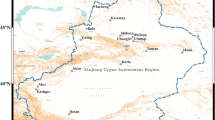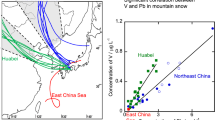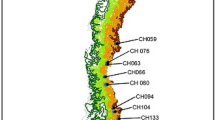Abstract
The Upper Silesian basin belongs to the largest industrial pollution sources in Europe and the city of Ostrava ranks among the worst-polluted urban areas in the European Union. To assess temporal and spatial trends in atmospheric pollution, we determined concentrations of S, Pb, Cu, Zn, As, Cd, Sb, and Al in snow in downtown Ostrava and at the Lysa Hora Mt. (LH), situated 33 km southeast. Snowpack surfaces were sampled in February 2011/2012, 2018, and 2019. At LH, we collected snow samples at four elevations (700, 900, 1100, and 1300 m) in order to quantify mountain slope gradients in the pollution that, in turn, might reflect vertical stratification of air masses in a region frequently affected by temperature inversions. 206Pb/207Pb and 208Pb/207Pb isotope ratios and back trajectories of air masses were used for pollution source apportionment. In year 1, there were clear-cut upslope decreases in concentrations of soluble pollutants. By year 3, the concentrations of soluble pollutants at LH decreased by 90% and the concentration gradients ceased to exist. Because annual precipitation totals at LH increase upslope by 75%, rates of deposition of soluble pollutants are now higher at the summit than those at the foot of the mountain. Hydrological control of deposition rates of soluble pollutants thus plays a more important role under lower pollution levels. Concentrations of soluble pollutants in Ostrava were up to 36 times higher compared with those at LH and also decreased by 90%. Lead isotopes indicated the continuing presence of gasoline Pb in the atmosphere, despite its ban in 2000.









Similar content being viewed by others
References
Aizen, V. B., Mayewski, P. A., Aizen, E. M., Joswiak, D. R., Surazakov, A. B., Kaspari, S., et al. (2009). Stable-isotope and trace element time series from Fedchenko glacier (Pamirs) snow/firn cores. Journal of Glaciology, 55, 190.
Aleksiayenak, Y., & Frontasyeva, M. (2019). A ten-year biomonitoring study of atmospheric deposition of trace elements at the territory of the Republic of Belarus. Ecological Chemistry and Engineering S, 26, 455–464.
Avak, S. E., Trachsel, J. C., Edebeli, J., Brutsch, S., Bartels-Rausch, T., Schneebeli, M., et al. (2019). Melt-induced fractionation of major ions and trace elements in an Alpine snowpack. Journal of Geophysical Research: Earth Surface, 124(7), 1647–1657.
Bing, H. J., Wu, Y. H., Zhou, J., Li, R., Luo, J., & Yu, D. (2016). Vegetation and cold trapping modulating elevation-dependent distribution of trace metals in soils of a high mountain in eastern Tibetan Plateau. Scientific Reports, 6, 24081.
Blackwell, B. D., & Driscoll, C. T. (2015). Deposition of mercury in forests along a montane elevation gradient. Environmental Science & Technology, 49, 5363–5370.
Bohdalkova, L., Novak, M., Stepanova, M., Fottova, D., Chrastny, V., Mikova, J., & Kubena, A. A. (2014). The fate of atmospherically derived Pb in Central European catchments: insights from spatial and temporal pollution gradients and Pb isotope ratios. Environmental Science & Technology, 48, 4336–4343.
Bohdalkova, L., Novak, M., Voldrichova, P., Prechova, E., Veselovsky, F., Erbanova, L., et al. (2012). Atmospheric deposition of beryllium in Central Europe: comparison of soluble and insoluble fractions in rime and snow across a pollution gradient. Science of the Total Environment, 439, 26–34.
Bridgman, H. A., Davies, T. D., Jickells, T., Hunova, I., Tovey, K., Bridges, K., & Surapipith, V. (2002). Air pollution in the Krusne Hory region, Czech Republic during the 1990s. Atmospheric Environment, 36, 3375–3389.
Chrastny, V., Vanek, A., Cadkova, E., Ruzickova, A., Galuskova, I., Faturikova, D., & Komarek, M. (2014). Lead migration in smelter-impacted deciduous and coniferous organic soil horizons based on a long-term in-situ implantation and laboratory column experiments. Applied Geochemistry, 48, 168–175.
Chrastny, V., Vanek, A., Teper, L., Cabala, J., Prochazka, J., Pechar, L., et al. (2012). Geochemical position of Pb, Zn and Cd in soils near the Olkusz mine/smelter, South Poland: effects of land use, type of contamination and distance from pollution source. Environmental Monitoring Assessment, 184, 2517–2536.
Cimova, N., Novak, M., Chrastny, V., Curik, J., Veselovsky, F., Blaha, V., et al. (2016). Lead fluxes and 206Pb/207Pb isotope ratios in rime and snow collected at remote mountain-top locations (Czech Republic, Central Europe): patterns and sources. Atmospheric Environment, 143, 51–59.
Conkova, M., & Kubiznakova, J. (2008). Lead isotope ratios in tree bark pockets: an indicator of past air pollution in the Czech Republic. Science of the Total Environment, 404, 440–445.
Dousova, B., Erbanova, L., & Novak, M. (2007). Arsenic in atmospheric deposition at the Czech – Polish border: two sampling campaigns 20 years apart. Science of the Total Environment, 387, 185–193.
Draxler, R.R., Rolph, G.D. HYSPLIT (HYbrid Single-Particle Lagrangian Integrated Trajectory) Model access via NOAA ARL READY. Website (http://ready.arl.noaa.gov/HYSPLIT.php). NOAA Air Resources Laboratory, Silver Spring.
Erbanova, L., Novak, M., Fottova, D., & Dousova, B. (2008). Export of arsenic from forested catchments under easing atmospheric pollution. Environmental Science and Technology, 42, 7187–7192.
Ettler, V., Mihaljevic, M., & Komarek, M. (2004). ICP-MS measurements of lead isotopic ratios in soils heavily contaminated by lead smelting: tracing the sources of pollution. Analytical and Bioanalytical Chemistry, 378, 311e317.
Francova, A., Chrastny, V., Sillerova, H., Kocourkova, J., & Komarek, M. (2017). Suitability of selected bioindicators of atmospheric pollution in the industrialized region of Ostrava, Upper Silesia, Czech Republic. Environmental Monitoring and Assessment, 189, 478.
Groscheova, H., Novak, M., Havel, M., & Cerny, J. (1998). Effect of altitude and tree species on δ34S of deposited sulfur (Jezeri catchment, Czech Republic). Water Air and Soil Pollution, 105, 295–303.
Hruska, J., & Kram, P. (2003). Modelling long-term changes in stream water and soil chemistry in catchments with contrasting vulnerability to acidification (Lysina and Pluhuv Bor, Czech Republic). Hydrology and Earth System Sciences, 7, 525–539.
Hunova, I. (2001). Spatial interpretation of ambient air quality for the territory of the Czech Republic. Environmental Pollution, 112, 107–119.
Kopacek, J., & Vesely, J. (2005). Sulfur and nitrogen emissions in the Czech Republic and Slovakia from 1850 till 2000. Atmospheric Environment, 39, 2179–2188.
Krachler, M., Zheng, J., Koerner, R., Zdanowicz, C., Fisher, D., & Shotyk, W. (2005). Increasing atmospheric antimony contamination in the northern hemisphere: snow and ice evidence from Devon Island, Arctic Canada. Journal of Environmental Monitoring, 7, 1169–1176.
Lazo, P., Stafilov, T., Qarri, F., Allejbeu, S., Bekhteshi, L., Frontasyeva, M., & Harmens, H. (2019). Spatial distribution and temporal trend of airborne trace metal deposition in Albania studied by moss biomonitoring. Ecological Indicators, 101, 1007–1017.
Madadzada, A. I., Badawy, W. M., Hajiyeva, S. R., Veliyeva, Z. T., Hajiyev, D. B., Shvetsova, M. S., & Frontasyeva, M. V. (2019). Assessment of atmospheric deposition of major and trace elements using neutron activation analysis and GIS technology: Baku – Azerbaijan. Microchemical Journal, 147, 605–614.
Matschullat, J., Maenhaut, W., Zimmermann, F., & Fiebig, J. (2000). Aerosol and bulk deposition trends in the 1990’s, Eastern Erzgebirge, Central Europe. Atmospheric Environment, 34, 3213–3221.
Menge, D. N. L., Batterman, S. A., Hedin, L. O., Liao, W. Y., Pacala, S. W., & Taylor, B. N. (2017). Why are nitrogen-fixing trees rare at higher compared to lower latitudes? Ecology, 98, 3127–3140.
Mihaljevic, M., Ettler, V., Strnad, L., Sebek, O., Vonasek, F., Drahota, P., & Rohovec, J. (2009). Isotopic composition of lead in Czech coals. International Journal of Coal Geology, 78, 38–46.
Ndlovu, N. B., Frontasyeva, M. V., Newman, R. T., & Maleka, P. P. (2019). Active biomonitoring of atmospheric pollution in the Western Cape (South Africa) using INAA and ICP-MS. Journal of Radioanalytical and Nuclear Chemistry, 322, 1549–1559.
Novak, M., Emmanuel, S., Vile, M. A., Erel, Y., Veron, A., Paces, T., et al. (2003). Origin of lead in eight Central European peat bogs determined from isotope ratios, strengths and operation times of regional pollution sources. Environmental Science & Technology, 37, 437–445.
Novak, M., Erel, Y., Zemanova, L., Bottrell, S. H., & Adamova, M. (2008). A comparison of lead pollution record in Sphagnum peat with known historical Pb emission rates in the British Isles and the Czech Republic. Atmospheric Environment, 42, 8997–9006.
Novak, M., Kirchner, J. W., Fottova, D., Prechova, E., Jackova, I., Kram, P., & Hruska, J. (2005). Isotopic evidence for processes of sulfur retention/release in 13 forested catchments spanning a strong pollution gradient (Czech Republic, central Europe). Global Biogeochemical Cycles, 19, 1–14.
Novak, M., Mikova, J., Krachler, M., Kosler, J., Erbanova, L., Prechova, E., Jackova, I., & Fottova, D. (2010). Radial distribution of lead and lead isotopes in stem wood of Norway spruce: a reliable archive of pollution trends in Central Europe. Geochimica et Cosmochimica Acta, 74, 4207–4218.
Novak, M., Sipkova, A., Chrastny, V., Stepanova, M., Voldrichova, P., Veselovsky, F., et al. (2016). Cu-Zn isotope constraints on the provenance of air pollution in Central Europe: using soluble and insoluble particles in snow and rime. Environmental Pollution, 218, 1135–1146.
Oulehle, F., Chuman, T., Hruska, J., Kram, P., McDowell, W. H., Myska, O., et al. (2017). Recovery from acidification alters concentrations and fluxes of solutes from Czech catchments. Biogeochemistry, 132, 251–272.
Paces, T. (1985). Sources of acidification in Central Europe estimated from elemental budgets in small basins. Nature, 315, 31–36.
Petrash, D. A., Buzek, F., Novak, M., Cejkova, B., Kram, P., Chuman, T., et al. (2019). Spatially resolved soil solution chemistry in a central European atmospherically polluted high-elevation catchment. Soil, 5, 205–221.
Piestrzynski, A., Pieczonka, J., Cwiertnia, T., & Zygo, W. (Eds.). (2015). 13th SGA biennial meeting Nancy – France. Geological Excursion Guide – Geology of the European Kupperschiefer, Lubin, Poland. Krakow.
R Core Team. (2019). R: a language and environment for statistical computing. In R Foundation for statistical computing. Vienna: Austria. URL http://www.R-project.org. Accessed 12 Dec 2019.
Reimann, C., & de Caritat, P. (2005). Distinguishing between natural and anthropogenic sources for elements in the environment: regional geochemical surveys versus enrichment factors. Science of the Total Environment, 337, 91–107.
Shabanda, I. S., Koki, I. B., Low, K. H., Zain, S. M., Khor, S. M., & Abu Bakar, N. K. (2019). Daily exposure to toxic metals through urban road dust from industrial, commercial, heavy traffic, and residential areas in Petalling Jaya, Malaysia: A health risk assessment. Environmental Science and Pollution Research, 26, 37193–37211.
Solgi, E., Keramaty, M., & Solgi, M. (2020). Biomonitoring of airborne Cu, Pb, and Zn in an urban area employing a broad leaved and a conifer tree species. Journal of Geochemical Exploration, 208, 106400.
Szynkiewicz, A., Modelska, M., Jedrysek, M. O., & Mastalerz, M. (2008). The effect of acid rain and altitude on concentration, δ14S, and δ18O of sulfate in the water from Sudety Mountains, Poland. Chemical Geology, 249, 36–51.
Tyszka, R., Pietranik, A., Kierczak, J., Ettler, V., Mihaljevic, M., & Weber, J. (2012). Anthropogenic and lithogenic sources of lead in Lower Silesia (Southwest Poland): an isotope study of soils, basement rocks and anthropogenic materials. Applied Geochemistry, 27, 1089–1100.
Vergel, K., Zinicovscaia, I., Yushin, N., & Frontasyeva, M. V. (2019). Heavy metal atmospheric deposition study in Moscow Region, Russia. Bulletin of Environmental Contamination and Toxicology, 103, 435–440.
Voldrichova, P., Chrastny, V., Sipkova, A., Farkas, J., Novak, M., Stepanova, M., et al. (2014). Zinc isotope systematics in snow and ice accretions in Central European mountains. Chemical Geology, 388, 130–141.
Wei, T., Dong, Z. W., Kang, S. C., Zong, C. L., Rostami, M., & Shao, Y. P. (2019). Atmospheric deposition and contamination of trace elements in snowpacks of mountain glaciers in the northeastern Tibetan Plateau. Science of the Total Environment, 689, 754–764.
Zimmermann, F., Matschullat, J., Bruggemann, E., Plessow, K., & Wienhaus, O. (2006). Temporal and elevation-related variability in precipitation chemistry from 1993 to 2002, eastern Erzgebirge, Germany. Water, Air and Soil Pollution, 170, 123–141.
Ziyaee, A., Hirmas, D. R., Karimi, A., Kehl, M., Macpherson, G. L., Lakzian, A., & Roshanizarmehri, M. (2019). Geogenic and anthropogenic sources of potentially toxic elements in airborne dust in northeastern Iran. Aeolian Research, 41, UNSP 100540.
Zuna, M., Mihaljevic, M., Sebek, O., Ettler, V., Handley, M., Navratil, T., & Golias, V. (2011). Recent lead deposition trends in the Czech Republic as recorded by peat bogs and tree rings. Atmospheric Environment, 45, 4950–4958.
Acknowledgments
We thank Prof. A. Komarek of Charles University and Petra Voldrichova of the Czech Geological Survey for assistance.
Funding
This study was funded by an intramural grant of the Czech Geological Survey to EP (DKRVO 2018-2022, project no. 310200).
Author information
Authors and Affiliations
Corresponding author
Additional information
Publisher’s Note
Springer Nature remains neutral with regard to jurisdictional claims in published maps and institutional affiliations.
Electronic Supplementary Material
ESM 1
(DOCX 18 kb)
ESM 2
(DOCX 14 kb)
Fig. S1.
Deposition of Pb and Zn on 10 mountain-top locations throughout the Czech Republic. Study site locations are marked by open circles in Fig. 1a. According to Cimova et al. (2016), and Novak et al. (2016). The following study sites were included in the comparison: ZAJ – Zajeci vrh, PRA – Pramenac, BUK – Bukova hora, POM – Polomka, TET – Tetrevec, VRH – Pricny vrh, ELK – Velky Polom, LOU – Kamenna Loucka , KAP – Kaprad, NEC – Kamenec. (PNG 2126 kb)
Rights and permissions
About this article
Cite this article
Prechova, E., Sebek, O., Strnad, L. et al. Temporal Changes in Mountain Slope Gradients in the Concentrations of Pollutants and Pb Isotope Ratios Near the Ostrava Conurbation (Upper Silesia, Czech-Polish Border). Water Air Soil Pollut 231, 246 (2020). https://doi.org/10.1007/s11270-020-04615-w
Received:
Accepted:
Published:
DOI: https://doi.org/10.1007/s11270-020-04615-w




